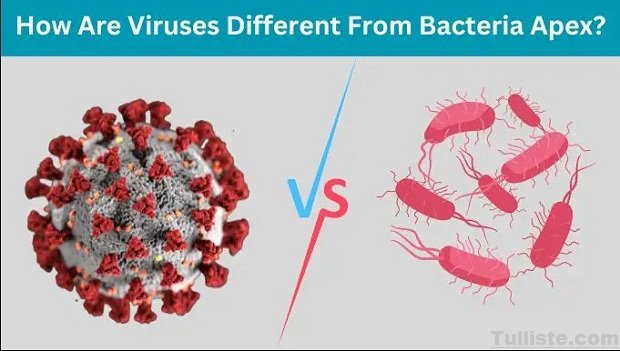Introduction to Viruses and Bacteria
Welcome to a fascinating journey into the microscopic world of viruses and bacteria! In this blog post, we will unravel the mysteries surrounding these tiny yet mighty organisms. Have you ever wondered how are viruses different from bacteria apex, or perhaps more intriguingly, how they are similar? Join us as we explore the intricate differences between viruses and bacteria and why it’s essential to understand their unique characteristics. Let’s dive in!
Basic Differences between Viruses and Bacteria
Let’s dive into the fundamental variances between viruses and bacteria. Viruses are not considered living organisms as they cannot replicate on their own – they need a host cell to multiply. On the other hand, bacteria are unicellular microorganisms that can reproduce independently through binary fission.
In terms of size, viruses are much smaller than bacteria. Viruses typically range from 20-400 nanometers in size, while bacteria can vary from around 200-1000 nanometers.
Furthermore, their structures differ significantly; viruses consist of genetic material (DNA or RNA) encased in a protein coat called a capsid. In contrast, bacteria have more complex structures with cell walls and membranes.
Regarding treatment options, antibiotics work against bacterial infections but not viral ones. This is due to the fact that antibiotics target specific structures found only in bacterial cells.
Understanding these basic variations is crucial for proper diagnosis and treatment when dealing with infections caused by either viruses or bacteria.
Similarities between Viruses and Bacteria
While viruses and bacteria are often viewed as starkly different, they do share some similarities that are worth noting. Both viruses and bacteria can cause infections in humans, leading to a range of symptoms from mild to severe. Additionally, both can be transmitted through various means such as respiratory droplets or contaminated surfaces.
Furthermore, both viruses and bacteria have the potential to evolve and develop resistance to treatments like antibiotics or antiviral medications. They also play crucial roles in scientific research, with their study helping scientists understand more about infectious diseases and how they spread.
Despite these commonalities, it’s essential to recognize that viruses and bacteria differ significantly in their structure, behavior, and treatment approaches. By understanding both their similarities and differences, we can better combat infections and protect public health.
How They Affect Humans Differently
When it comes to how viruses and bacteria affect humans, their impact can vary significantly. Viruses are known for causing various illnesses like the flu, common cold, and COVID-19. They rely on host cells to multiply and spread throughout the body rapidly.
On the other hand, bacteria can lead to infections such as strep throat or urinary tract infections. Unlike viruses, some bacteria are beneficial and play a crucial role in processes like digestion. However, harmful bacteria can cause serious diseases if left untreated.
Viruses tend to be more challenging to treat since antibiotics don’t work against them; instead, antiviral medications may be prescribed depending on the specific virus. Bacterial infections are typically treated with antibiotics targeted at killing or inhibiting bacterial growth.
Understanding these differences is vital in determining the appropriate treatment for illnesses caused by either viruses or bacteria. It’s essential to consult healthcare professionals for accurate diagnosis and management of infections effectively tailored to each situation.

Common Misconceptions about Viruses and Bacteria
One common misconception about viruses and bacteria is that they are the same thing. In reality, they are quite different in terms of structure, behavior, and how they affect living organisms. While both can cause infections, viruses are much smaller than bacteria and can only replicate inside host cells.
Another misconception is that all bacteria are harmful. The truth is that our bodies actually rely on beneficial bacteria to maintain essential functions like digestion and immunity. Not all bacteria should be viewed as villains!
People often believe antibiotics can treat viral infections just as effectively as bacterial ones. However, antibiotics only work against bacterial infections; they have no effect on viruses. Overuse of antibiotics can lead to antibiotic resistance, a serious global health concern.
It’s important to understand these misconceptions to make informed decisions about healthcare and hygiene practices. By knowing the differences between viruses and bacteria, we can better protect ourselves from illness and prevent the spread of infections in our communities.
Importance of Understanding the Differences
Understanding the differences between viruses and bacteria is crucial for various reasons. It helps in proper diagnosis and treatment of illnesses. By knowing whether an infection is viral or bacterial, healthcare professionals can prescribe the appropriate medications.
Moreover, understanding these distinctions aids in preventing the spread of diseases. Different pathogens require different containment measures, so having this knowledge enables us to implement effective strategies to control outbreaks.
Additionally, awareness about viruses and bacteria assists in vaccine development. Vaccines target specific pathogens, so accurate identification is vital for creating vaccines that provide immunity against harmful infections.
Furthermore, comprehending the variances between viruses and bacteria promotes overall public health education. When people are informed about how these microorganisms function differently, they can make better choices to protect themselves and others from getting sick.
Conclusion
Understanding the distinctions between viruses and bacteria is crucial for various reasons. By knowing how they differ in structure, reproduction, and behavior, we can better comprehend how to prevent and treat infections effectively. This knowledge helps healthcare professionals develop targeted treatments and vaccines that specifically combat each type of microorganism.
Moreover, understanding these variances aids in public health measures such as disease prevention strategies, outbreak control, and antibiotic stewardship. It empowers individuals to make informed decisions about their health and hygiene practices.
In essence, grasping the disparities between viruses and bacteria apex plays a vital role in safeguarding public health on a global scale. So let’s stay informed and aware to protect ourselves from potential threats posed by these microscopic organisms.


